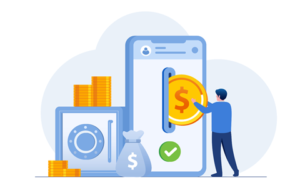In a survey conducted by IBRIS in September 2020, a staggering 83% of respondents felt that mobile apps make their daily lives easier. This article will show you how to approach this most effectively if you’re thinking about developing an app for your product or service.
How do you create a mobile app?
The process of creating a dedicated application can be broken down into three paths:
- Writing the application yourself;
- Hiring a design and development team;
- Outsourcing the work to a technology partner.
Each option poses different challenges.
It requires experience in developing and coding projects to build a mobile app, in which case you are responsible for both the design and the programming.
Alternatively, you can form a team to develop the right product. To make the entire team work effectively, you must know exactly which specialists to hire and how to set up a process. By far, that is the most expensive option.
The third option – outsourcing to a technology partner – is the fastest and most effective method in most cases. An experienced team of specialists will handle your project, leaving you to focus on the business aspect of the whole venture.
How long does it take to develop a mobile or web app?
We posed this question to Oksana Wojtkiewicz, heading the Marketing and Sales department at Solwit S.A., who oversees project execution: “It takes between four and nine months to create a fully functional and quite high-end bespoke software, but this timeline can shrink or stretch depending on the complexity and requirements of the project.”
If you want to know precisely how long it takes to develop an app, we encourage you to read the article: “Everything you need to know about creating a dedicated app” in Solwit’s blog.
Application development process with a technology partner
The process of developing a mobile or web app in 5 steps:
1. Business analysis
To develop a mobile app, you need to know the answer to two fundamental questions: how will it be used, and what problem will it solve for your customers?
This will form the basis of your brief, in which you present your technology partner with the basic functionality and the app’s overview. Your selected company will prepare an initial proposal and specification based on the information provided.
At this stage, carefully define your expectations, needs, and goals. By doing so, you will avoid future costs in the long run.
2. Application design
Creating individual views of the application allows you to visualize how it will look after development. This step involves planning the application’s user scenarios, schemes, and layout with your partner.
You will be backed by a team of experts who match the right tools that will allow you to build a functional and scalable solution.
3. Project planning
After the design stage, it is time to carefully plan the project team’s tasks, priorities, and schedule. At this stage, an experienced Project Manager will take responsibility for this step and create a backlog, a sorted list of tasks that need to be completed. It will take just a few hours to complete most of these tasks, so you’ll be able to see your idea become a working product pretty quickly.
4. Application development
If the plan of your project is ready, it is time to kick off the programming stage. In custom applications, 90% of the time is spent on development. Project complexity determines how long it takes to prepare the first functionalities.
The most costly delays occur when the project scope or requirements change during this step. It’s because of this that the planning and business analysis phases are so critical.
The development process concludes with a presentation of the results: you will see the application’s basic but working functionalities. As a result, you can verify whether they match your assumptions.
5. Testing your dedicated application
The proper course of application testing will be demonstrated using the example of Solwit’s team – a software house awarded the prestigious status of Platinum Partner of ISTQB – the international software testing certification board.
At Solwit, application testing is handled by quality assurance experts. They test usability, assess the code’s quality, and check the product’s security, comparing the whole with the highest industry standards. The most advanced projects can take several weeks or even months to complete the application testing process.
Have an idea for a mobile or web application?
Are you looking for an experienced technology partner? Check out the projects Solwit’s team has completed with clients who, just like you, needed custom software.
If you already have a ready idea and an application brief, Solwit’s experienced experts will get you a quote in as little as 24 hours from submission!
If your needs aren’t clearly outlined, get in touch and set up a free consultation to work together on the next steps.


































